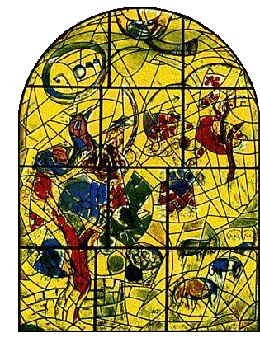In 1962, when the twelve stained glass windows he created for Hadassah Hebrew University Medical Center were formally installed, Marc Chagall said,
How is it that the air and earth of Vitebsk, my birthplace, and thousands of years of exile, find themselves mingled in the air and earth of Jerusalem?
How could I have thought that not only my hands with their colors would direct me in my work, but that the poor hands of my parents and of others and still others with their mute lips and their closed eyes, who gathered and whispered behind me, would direct me as if they also wished to take part in my life?
What’s a Jewish artist? A Jewish person who makes art? A Jewish person who makes Jewish art? What’s Jewish art?
Big philosophical questions. We’re not going there.
Many people have asked us about ways to bring art and art appreciation into the Jewish classroom. We’ll stick to visual artists and do that in two parts. Today, we’ll talk about well known Jewish artists. Next time we’ll talk about strategies and activities to help students get inside of Jewish art.
I asked the 5 things advisory group to list 5 Jewish artists kids should know about. Here are more than 5 artists recommended, with notes, by Laurie Bellet, our “resident” art guru.
Marc Chagall – Even though many teachers say they want to teach “beyond Chagall,” he is a new acquaintance and important for students. In supplemental classrooms I employ Chagall for reinforcing edot. The most commonly taught print is ‘I and the Village.’ It is readily available, with teaching guides, and in various sizes. There are many art activities to be found online and in activity books if a teacher wants a creative follow-up experience. For more sophisticated (8th through 12th graders) students, I have also taught ‘White Crucifixion.’
 Judy Chicago – As a prominent, living artist it is crucial that a teacher read her artist statements and respect the intent of her works. In fact, last year, she wrote to a leading art teacher publication because, while pleased that teachers are sharing her work “The Dinner Party,” she wants study of her work done as she intended. That said, her work can be taught for honoring women who have been significant in Jewish history. (Not for student self portraiture). I have also taught from her work ‘Rainbow Shabbat,’ (pictured at right) which is part of her Shoah series.
Judy Chicago – As a prominent, living artist it is crucial that a teacher read her artist statements and respect the intent of her works. In fact, last year, she wrote to a leading art teacher publication because, while pleased that teachers are sharing her work “The Dinner Party,” she wants study of her work done as she intended. That said, her work can be taught for honoring women who have been significant in Jewish history. (Not for student self portraiture). I have also taught from her work ‘Rainbow Shabbat,’ (pictured at right) which is part of her Shoah series.
Helen Frankenthaler (Ad Reinhardt and other abstract expressionists) and Mark Rothko (Barnett Newman and other color field artists) – fabulous for probing kavannah, responding to historical events, responding to music. Students are free to paint in broad strokes and colors and do not do representational work. An artist statement or meaningful title is an essential conclusion to validate the experience.
Solomon Solomon – beyond a brief discussion about names….Solomon Solomon was the innovator of strategic camouflage and a fabulous hook for engaging all students in the beginning of the year. His work ‘High Tea in the Sukkah‘ is a statement of how contemporary British Jewish society sought to fit within their cultural framework. The piece is predominantly done in shades of brown. He did, however, do a woman’s stylish hat and a tea cup in a striking blue. The piece is seen on some Jewish calendars and in books about Jewish artists of the 19th and early 20th centuries. I teach this at, you guessed it…Sukkot!
Daniel Moritz Oppenheim (Malcah Zeldis, Mauricy Gottlieb and other diarists) – Oppenheim was the first Jewish artist to document the sequence of Jewish life during Shabbat in 19th century Germany. Gottlieb depicted many synagogue scenes, always including a version of himself either as a child a young adult or into his projected old age. Zeldis’ work is generally available in calendar form. Her bright colors and flat picture plane make her a pleasant artist to tribute in class work.
Roy Lichtenstein – very popular among students. His brash comic book innovations are so much fun to imitate in student work as enlargements of Purim, Pesach or Chanukah heroes and villains.
Here is a list of other artists suggested by our group:
Amedeo Modigliani
Al Hirshfeld,
Anna Ticho
Camille Pissarro
R.B. Kitaj
Wolf Kahn
Ben Shahn
Leonard Baskin
Max Weber
Louise Nevelson
Reuven Reuben
Morris Louis
Frida Kahlo
Friedl Dicker-Brandeis
Maurice Sendak
Lee Krasner
Chaim Soutine
Jacque Lipchitz
Tzion Ozeri
Who was the first Jewish artist? We usually think of Bezalel, the biblical artist who built and decorated the Ark of the Covenant (Exodus 36:2).
Dale Cooperman, a pre-school teacher in Albuquerque, suggests otherwise. She wrote that the first Jewish artist is God:
Who ever had such an amazing eye for color and balance in the world? Who can ever be deemed more creative , whether referencing nature in its inherent beauty, the extraordinary variety of fauna and flora, or the majesty of the human being?
Resources;
http://www.jewishvirtuallibrary.org/jsource/Judaism/artists.html
With special thanks to Laurie Bellet, and to Peter Stark, Dale Cooperman, Rabbi Susie Moskowitz, Susan Edelstein, Shari Pratt, Rabbi Jerry Kane, Sharon Morton, Paul Epstein, Ira Wise, Michael Raileanu, Marian Gorman, Judi Berliner, and Judy Aronson.


 by
by